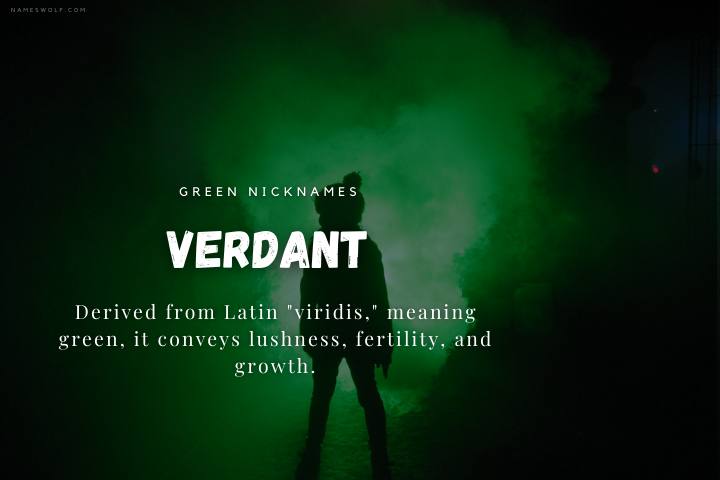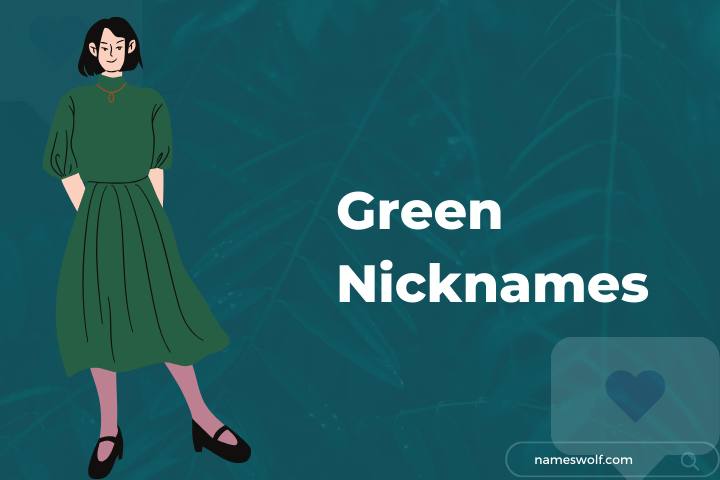In a world increasingly aware of the urgent need for sustainability, it’s refreshing to see individuals adopting green practices in every aspect of their lives, including the way they address themselves or others. Our aim is to delve into the realm of Green Nicknames, looking beyond the traditional options and embracing more thoughtful, nature-inspired alternatives.
Join us as we discover the beauty and significance behind these unique appellations that not only reflect a commitment to the environment but also promote a deeper connection with the natural world.
Green Nicknames
Emerald: Originating from the Greek “smaragdos,” it’s a green gemstone symbolizing renewal and rebirth.
Forest: Evokes images of woodlands, representing nature, tranquility, and connection to the earth.
Leafy: Derived from “leaf,” it signifies an affinity for foliage, growth, and the outdoors.
Jade: From the Spanish “piedra de ijada,” meaning “stone of the side,” jade is believed to protect and heal.
Evergreen: Signifies something that remains vibrant and green throughout the year, like pine trees in winter.
Grasshopper: Named after the green insect, symbolizing growth, adaptability, and taking leaps.
Minty: Relates to the refreshing aroma and flavor of mint leaves, symbolizing freshness and coolness.
Shamrock: A symbol of Ireland and St. Patrick’s Day, representing luck, faith, hope, and love.
Green Bean: A playful nickname combining the color green with a common vegetable.
Verdant: Derived from Latin “viridis,” meaning green, it conveys lushness, fertility, and growth.
Mossy: Refers to the velvety green moss found in damp environments, symbolizing resilience and adaptability.
Olive: Named after the olive tree, it signifies peace, wisdom, and prosperity.
Woodland: Suggestive of a peaceful and natural forest environment, perfect for nature enthusiasts.
Clover: A small, green plant known for its four
Fern: A type of green, leafy plant found in forests, associated with grace, sincerity, and growth.
Pistachio: Named after the nut, it symbolizes exotic flavor, uniqueness, and a hint of green.
Envy: Conveys the idea of the green.
Lime: Named after the fruit, it symbolizes zest, vibrancy, and a touch of tartness.
Chlorophyll: The green pigment in plants responsible for photosynthesis, representing life, and energy.
Cactus: Named after the desert plant, symbolizing resilience, adaptability, and enduring tough conditions.
Meadow: Refers to a field of grass and wildflowers, symbolizing natural beauty and serenity.
Sage: Named after the herb, it signifies wisdom, knowledge, and profound insight.
Basil: Named after the aromatic herb, symbolizing love, devotion, and fragrant charm.
Leprechaun: A mythical Irish creature, representing mischief, magic, and Irish folklore.
Algae: Simple aquatic plants, symbolizing growth, adaptability, and the importance of aquatic ecosystems.
Ivy: A climbing plant, symbolizing fidelity, friendship, and the enduring bonds of love.
Hopper: Refers to grasshoppers and symbolizes spring, new beginnings, and leaps of faith.
Zucchini: Named after the green vegetable, it represents growth, versatility, and creativity in cooking.
Spinach: A leafy green vegetable, symbolizing health, strength, and vitality.
Pea Pod: Represents unity, togetherness, and the idea that there’s strength in numbers.
Ginkgo: Named after the ancient tree, it symbolizes longevity, adaptability, and resilience.
Lush: Signifies richness, abundance, and luxurious growth, often seen in thriving gardens.
Bamboo: Represents flexibility, strength, and growth, as bamboo is a resilient and fast
Thyme: Named after the herb, it symbolizes the passage of time, memories, and flavorful experiences.
Pinecone: Refers to the seed cone of a pine tree, symbolizing growth, regeneration, and potential.
Serpentine: A green mineral, symbolizing transformation, healing, and protection.
Gaia: Named after the Greek Earth goddess, representing the Earth, nature, and interconnectedness.
Broccoli: A green vegetable, symbolizing health, nutrition, and vitality.

Paddy: Refers to a flooded field for rice cultivation, symbolizing fertility, abundance, and hard work.
Acorn: The nut of an oak tree, symbolizing potential, growth, and the start of something great.
Sprout: Represents new beginnings, growth, and the emergence of young plants.
Teal: A shade of greenish.
Topiary: Refers to the art of shaping shrubs and trees, symbolizing creativity, and precision.
Limelight: A bright greenish.
Honeydew: A sweet green melon, symbolizing sweetness, refreshment, and indulgence.
Gourd: Refers to various vine.
Kiwifruit: Named after the kiwi bird, it represents uniqueness, flavor, and a touch of green.
Malachite: A green mineral, symbolizing protection, transformation, and healing.
Bud: Represents potential, growth, and the promise of blossoming into something beautiful.
Greenie
Seaweed
Kiwi
Alpine
Avocado
Pine
Greenlight
Artichoke
Chartreuse
Peridot
Viridescent
Meadowlark
Grassy
Olive Branch
Green Thumb
Forest Elf
Leafy Greens
Peacock
Green Apple
Rainforest
Lush Life
Glade
Greenhouse
Grasshugger
Cloverleaf
Botanist
Green Goddess
Jadeite
Mossy Rock
Ferny
Parsley
Fiddlehead
Basilisk
Agate
Spinach Lover
Cucumber
Seaweed Snacker
Gnome
Olive You
Mint Condition
Zesty Zucchini
Pine Needle
Green Valley
Ginkgo Biloba
Herbivore
Chloroform
Grassroots
Leaf Blower
Rainbow Green
Everlasting Green
Ivy League

Avocado Toast
Mint Julep
Lucky Clover
Teal Me More
Parsley Sage
Bonsai
Beanstalk
Romaine
Green Acres
Zestful Zucchini
Leaf Peeper
Melon Green
Peapod Pal
Aloe Vera
Limelight Lover
Botanical Beauty
Green Enthusiast
Cucumber Cruncher
Forest Dweller
Algae Eater
Emerald Isle
Vineyard
Pesto Princess
Fern Gully
Basil Breeze
Jade Jaguar
Lucky Leprechaun
Meadow Walker
Sproutling
Rainforest Roamer
Avocado Aficionado
Gourd Guru
Green Wave
Olive Oil
Herb Whisperer
Teal Time
Zucchini Zest
Clover Catcher
Evergreen Explorer
Leafy Loveliness
Minty Marvel
Mossy Marvel
Jade Jester
Enchanted Forest
Kiwi Kisser
Woodland Wonder
Fern Finder
Basil Bliss
Grasshopper Guru
Ivy Insider
Vineyard Voyager
Cactus Climber
Lemon Lime
Algae Alchemist
Pineapple
Cucumber Crunch
Parsley Perfection
Mint Majesty
Clover Collector
Serpent Slayer
Lime Lover
Topiary Artist
Acorn Adventurer
Bamboo Beauty
Herbalist
Viridescent Visionary
Olive Obsession
Fern Friend
Basilic Wizard
Ginkgo Guardian
Grassy Knoll
Shamrock Seeker
Jade Juggernaut
Ivy Enthusiast
Serpentine Seeker
Pineapple Prince
Basil Benefactor
Teal Tornado
Zucchini Zealot
Lush Landscape
Bamboo Babe
Verdant Voyager
Parsley Prince
Mint Marvel
Evergreen Expert
Leafy Luminary
Emerald Explorer
Also Read:
Conclusion
In conclusion, the use of green nicknames is a simple yet effective way to raise awareness about environmental issues and promote sustainability. Whether it’s Eco-Warrior or Planet Protector, these playful monikers can inspire individuals to adopt greener habits and take action to protect the planet.
